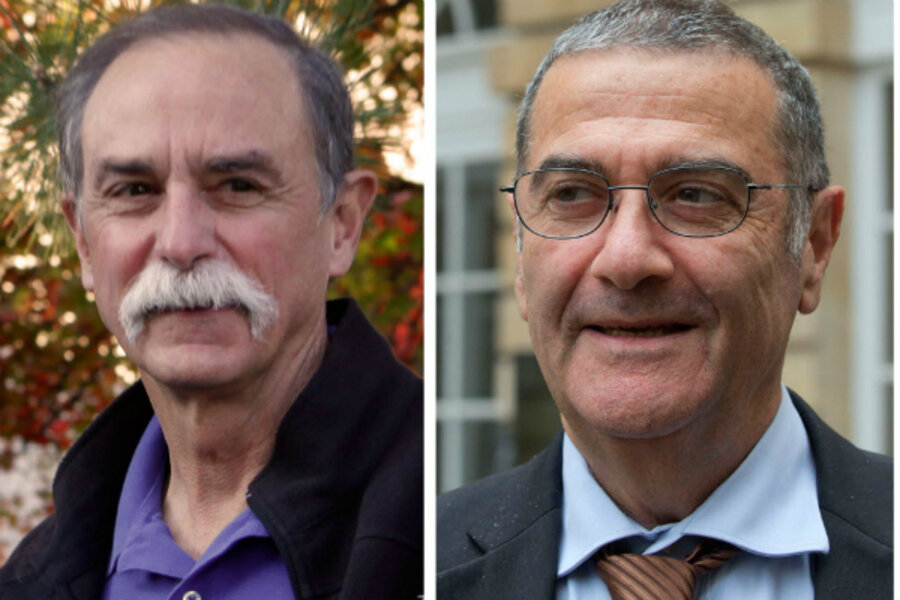Nobel Prize for Physics rewards 'groundbreaking' quantum experiments
Loading...
A French and an American physicist are sharing the 2012 Nobel Prize in Physics for, in a sense, letting a cat out of the box. And not just any cat, but one that is dead and alive at the same time.
Welcome to the odd world of quantum physics.
Each winner independently demonstrated something long thought impossible: measuring and even controlling the weird, quantum properties of a subatomic particle without instantly forcing the particle to shed its quantum behavior.
In announcing the winners – Serge Haroche, with the College de Paris and the École Normale Supérieure, and David Wineland, with the US National Institute for Standards and Technology – on Tuesday, the Nobel Prize committee termed the duo's work "ground-breaking experimental methods."
The experiments were conducted in 1995 and '96. They have helped pave the way for more-accurate atomic clocks, whose exquisitely accurate ticks are based on vibrations of atoms instead of the swing of a pendulum or the geared unwinding of a spring. And they have led to rudimentary forerunners of logic circuits for quantum computers – the next major advance researchers are pursuing as they seek faster, more-capable number-crunching hardware.
Hearing from the winners that the award was a surprise has almost become a cliché. Yet for Dr. Wineland, "it really was a surprise," he said during a press conference Tuesday afternoon.
In past years, he had heard "rumblings" that he was a potential winner, "but this year I hadn't, honestly, heard any rumblings. So I thought, Well, maybe my time has passed."
A phone call from Stockholm at 4 a.m. Mountain Daylight Time proved otherwise.
As for Dr. Haroche, he told reporters he and his wife were out for a walk in Paris when his cell phone rang and he saw the Swedish country code on caller ID.
"I was in the street and passing near a bench, so I was able to sit down immediately," he recalled. The realization that he'd was a co-recipient this year was overwhelming, he said.
When the two men head to Stockholm to accept the award and split the 8 million Swedish krona ($1.2 million) purse, it will be as longtime friends.
"I have known Serge Haroche, oh, I don't know, 25 or 30 years. We have become good friends," Wineland says.
The two men and their colleagues overcame what many had held up as an insurmountable barrier to studying particles as quantum systems. The barrier found its most famous formulation as Schrödinger's cat – a thought experiment that the Austrian physicist Erwin Schrödinger offered up in 1935 to show the bizarre conclusions quantum mechanics implied if it was extended beyond the world of subatomic particles.
He imagined a cat in a steel box, sharing its space with a source of radioactive material, a radiation detector, and a container of hydrogen cyanide. If the detector sensed the decay of an atom, it would trigger a device that would break the container, poisoning the cat.
Governed by quantum mechanics, if the particle had a 50-50 chance of decaying, the cat has a 50-50 chance of being dead or alive. In effect, the cat would be assumed to be both dead and alive at the same time until someone from the Humane Society opened the box to check. Then the cat either is dead or alive.
Wineland and Haroche tackled the challenge of detecting a superposition of several states at once from opposite directions.
Wineland captured beryllium ions in an electric field, then subjected the ions to the big chill – cooling them to within a gnat's eyelash of absolute zero using laser pulses to gradually reduce the vibrations of the ions. Another laser teased the ions into a kind of no-man's land between two energy states, producing an ion that, in effect, has an equal chance of settling on either one.
Haroche and his team went at the challenge from another direction – trapping microwaves in a tiny device whose reflective mirrors are said to be the shiniest in the world, then using solitary atoms as probes of the microwave photons he's tricked into a cat-like state. The approach also allowed him to come up with a way of watching how the quantum state of a photon can change with time.








